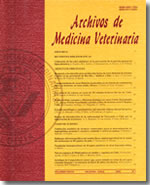Efficacy of sildenafil therapy for pulmonary hypertension in dogs: a systematic review
Main Article Content
Abstract
This systematic review aimed to assess the efficacy of sildenafil in the treatment of pulmonary hypertension (PH) in dogs and, when possible, to propose recommendations for or against its use. Electronic searches were carried out using six international databases. The inclusion criterion was in vivo clinical trials that assessed the efficacy of sildenafil in the treatment of naturally occurring PH. The scoring system was designed to take into account aspects such as the form of distribution and masking of experimental treatments, the number of animals, association with other drugs, diagnostic methods for PH, evaluations of the clinical response to treatment and adverse effects. A total of five papers were found. In general, the clinical condition and quality of life of the animals improved after sildenafil therapy, and the occurrence of adverse effects was uncommon. Echocardiographic findings provided evidence for changes in pulmonary arterial pressure which could be associated with alterations in physical activity and survival time. Still, the methodological quality of the studies was low, only one of them was a randomised, placebo-controlled and double-blind clinical trial. Furthermore, with modest evidence, this study allowed the recommendation that sildenafil is an important therapy which can play a positive therapeutic role in the treatment of canine PH. Additionally, prospective, randomised, blinded and controlled studies with a larger number of animals assessing physical activity and the adverse effects of sildenafil and other drugs in association are recommended to evaluate the efficacy of this drug in dogs.

